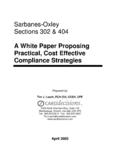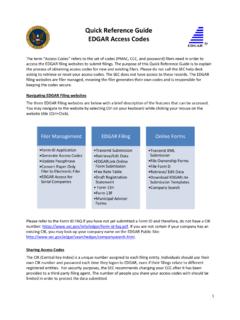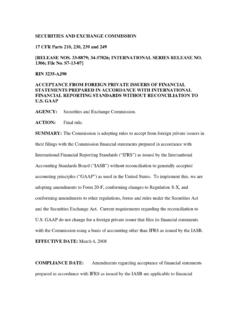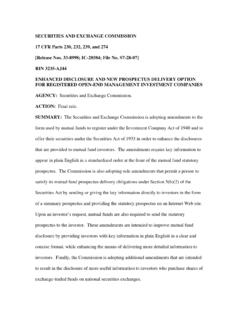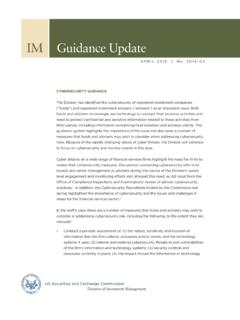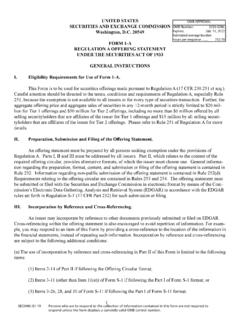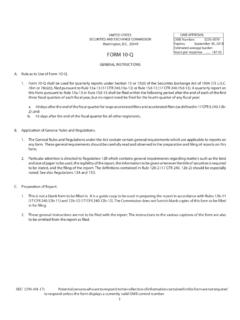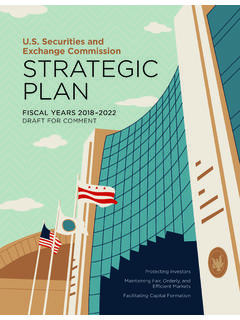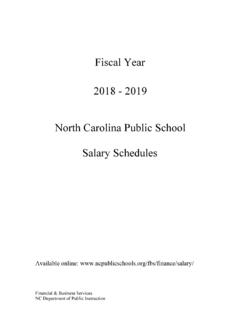Transcription of Fiscal Year 2020 Congressional Budget Justification and ...
1 SECURITIES AND. E XC H A N G E CO M M I SS I O N. Fiscal YEAR 2020. Congressional Budget Justification Annual Performance Plan Fiscal YEAR 2018. Annual Performance Report PROTECTING. INVESTORS. MAINTAINING. FAIR, ORDERLY, AND EFFICIENT. MARKETS. FACILITATING. C A P I TA L. FORMATION. Contents Agency and Mission Executive 3. Mission, Vision, Values, and History and Organizational FY 2020 Budget Request Positions and Full-Time Equivalents by Obligations by Object Strategic Goal and Request Summary of FY 2020 Appropriations FY 2020 Budget Request by Other 81. Risks, Internal Controls, and Management Cross-Agency Collaboration ..88. Evidence Building ..91. Links to Additional Information and Resources .. 93. FY 2020 Annual Performance Performance Plan by Strategic 97.
2 FY 2018 Annual Performance FY 2018 Annual Performance Report 109. Performance by Strategic Goal and Strategic 110. 141. Appendix A: Verification and Validation of Performance Appendix B: SEC's Responses to Government Accountability Office Appendix C: Discontinued Performance Goals and 168. Appendix D: Information Technology Resource ABOUT THIS REPORT. The Congressional Budget Justification (CBJ) is the annual presentation to Congress that justifies the Securities and Exchange Commission's (SEC) Budget request. This report also includes the Annual Performance Plan (APP) for Fiscal year (FY) 2020 and the Annual Performance Report (APR) for FY 2018, focusing on the agency's strategic goals and performance results. This report provides information that satisfies requirements contained in the following laws and regulations listed below.
3 Government Performance and Results Modernization Act of 2010. Office of Management and Budget (OMB) Circular A-11, Preparation, Submission, and Execution of the Budget Government Management Reform Act of 1994. Reports Consolidation Act of 2000. OMB Circular A-136, Financial Reporting Requirements An electronic version of this document and its components is available at To comment on the SEC's FY 2020 CBJ and APP and FY 2018 APR, email Agency and Mission Information Executive Mission, Vision, Values, and 8. History and Organizational This page intentionally left blank EXECUTIVE SUMMARY. The Securities and Exchange Commission (SEC) is pleased to submit its Budget request for Fiscal year (FY) 2020. The SEC is requesting $ billion in support of 4,694 positions and 4,502 full-time equivalents (FTE) to carry out our statutory mission to protect investors, maintain fair, orderly, and efficient markets, and facilitate capital formation.
4 These expenses will be offset by matching collections of fees on securities transactions. The request would permit the SEC, in particular, to (1) pursue the initiatives in the SEC's 2018 2022 Strategic Plan;1 (2) modernize key information technology (IT) systems and enhance the security of our systems and data; and (3) fill 34 new positions that will enhance our ability to carry out our mission and execute on our strategic goals. The SEC's broad mission covers a lot of ground. We oversee over $97 trillion in securities trading annually on equity markets and the activities of over 27,000 registered market participants, including investment advisers, mutual funds, exchange-traded funds (ETF), broker-dealers, municipal advisors, and transfer agents. We are responsible for selectively reviewing the disclosures and financial statements of almost 8,000 reporting companies, of which approximately 4,300 are exchange listed.
5 Of the top 100 public companies in the world, 81 fall under the SEC's reporting requirements. The SEC also engages and interacts with the investing public on a daily basis through a number of activities ranging from our investor education programs to alerts on We provide critical market services through our IT. systems. On a typical day, investors and other market participants access disclosure documents through the Electronic Data Gathering, Analysis, and Retrieval (EDGAR) system 41 million times. The agency also oversees 22 national securities exchanges, 10 credit rating agencies, and 7 active registered clearing agencies, as well as the Public Company Accounting Oversight Board (PCAOB), the Financial Industry Regulatory Authority (FINRA), the Municipal Securi- ties Rulemaking Board (MSRB), the Securities Investor Protection Corporation (SIPC), and the Financial Accounting Standards Board (FASB).
6 FY 2020 is our first Budget request tied to the SEC's new Strategic Plan, which reflects our strong desire to adapt the SEC's operations to meet more effectively the challenges of ever-evolving securities markets while recognizing the importance of being a responsible steward of federal resources. Building on our FY 2019 request, our FY 2020 request would enable the SEC to engage in a number of initiatives that would benefit the long-term interests of our Main Street investors, including promulgating rules to increase access to investment opportunities for investors and access to capital for businesses; enforcing the federal securities laws and punishing bad actors that violate those laws; and strengthening our cybersecurity and IT infrastructure and expertise.
7 The request also would allow the agency to add 34 new 1 AGENCY AND MISSION INFORMATION | 3. positions that, along with the FY 2019 request, would enable the SEC to restore approximately one-third of the 400 positions lost to attrition over the past two Fiscal years. By enabling us to invest in staff with skills and expertise in vital areas such as cybersecurity and market oversight, this request would enable us to shift or expand our focus in certain key areas for the benefit of our Main Street investors and companies, and to adapt to keep pace with changes in the markets we oversee. The following sections highlight the agency's key priorities for FY 2020 in implementing our new Strategic Plan. Focus on the long-term interests of our Main Street investors Serving the long-term interests of our Main Street investors is a top priority, and the SEC's new Strategic Plan identifies a number of goals to achieve this, including increasing investor access to long-term, cost-effective investment opportunities; enhancing our outreach, education, and consultation efforts; modernizing the design, delivery, and content of disclosures to investors.
8 And pursuing enforcement and examination initiatives focused on identifying and addressing misconduct that impacts retail investors. The FY 2020 request would enable the SEC to expand the new Office of the Advocate for Small Business Capital Formation (OASB), whose mission is to provide outreach, offer assis- tance, and give voice at the Commission to small businesses and small business investors. In December 2018, the Commission selected the Advocate, and the FY 2020 request would enable us to bring OASB's total staffing to eight positions. The request would also enable us to support the work of a new Advisory Committee on Small Business Capital Formation designed to solicit ideas from the public about ways to better facilitate small business capital formation.
9 Further, the FY 2020 request would add one new position to the Division of Corporation Finance to assist with new capital formation policy and rulemaking initiatives. This would include the continuation of efforts to consider a scaled disclosure framework for smaller companies; disclosure modernization and simplification; and anticipated recommenda- tions arising out of our upcoming request for comment on the exemptive offering regulatory framework. The FY 2020 request also would add six positions to the Division of Enforcement (ENF) to expand our capability to investigate and prosecute alleged misconduct involving actions that affect Main Street investors. These positions will bolster our Retail Strategy Task Force, which develops strategies to identify and combat practices that harm Main Street investors.
10 The FY 2020 request would also enable us to restore funding that is used to provide cost-effective contractor support to ENF investigators and litigators, including specialized expertise and paralegal support. 4 | FY 2020 Congressional Budget Justification . Our examination program, executed by the Office of Compliance Inspections and Examina- tions (OCIE), is another key area where our work directly protects the interests of Main Street investors. The SEC in recent years has been leveraging data, advanced risk analytics, and human capital to successfully focus its limited resources where they can have the most benefit. These efforts have resulted in a number of significant improvements, including expanded coverage of investment advisers even as the amount of assets under management by investment profes- sionals continues to increase.


